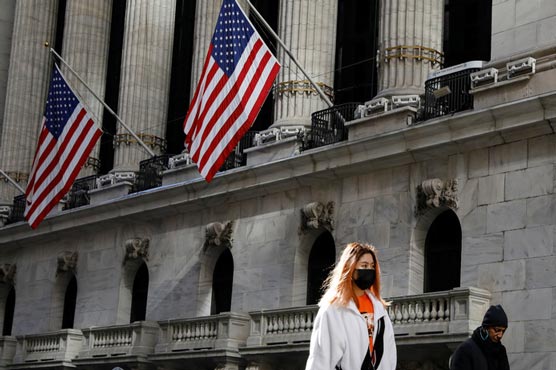How coronavirus pandemic develops in US over past 70 days

On March 11, WHO said that the COVID-19 outbreak can be characterized as a pandemic
(Reuters) - Supposedly rated as one of the most prepared countries, the United States has reported 636,000 confirmed cases and over 28,000 deaths for COVID-19, the largest number of both coronavirus fatalities and infections so far since the country reported its first case in Washington State on January 21, 2020.
On April 11, U.S. President Donald Trump officially approved the major disaster declaration for the state of Wyoming, being the final U.S. state to do so. That means all the 50 states as well as the Washington, D.C., U.S. Virgin islands, the Northern Mariana Islands, Guam and Puerto Rico are under major disaster status for the first time in history.
Back to last year, the country just finished a series of exercises from January to August with the involvement of the U.S. Department of Defense, U.S. Department of Veterans Affairs, U.S. National Security Council, Red Cross, American Nurses Association, insurance companies and some hospitals.
The scenario, code-named "Crimson Contagion", imagined an influenza pandemic that was first detected in Chicago. After 47 days later, the World Health Organization declared a pandemic but it was too late as a total of 110 million Americans were expected to be affected, leading to 7.7 million hospitalized and 586,000 dead.
The U.S. Department of Health and Human Services (HHS) submitted a report to Trump in October based on the exercises.
The exercise went on to predict how the situation in the U.S. would worsen as the weeks passed, according to a report published by the New York Times.
"Confusion emerged as state governments began to turn in large numbers to Washington for help to address shortages of antiviral medications, personal protective equipment and ventilators. Then states started to submit requests to different branches of the federal government, leading to bureaucratic chaos," it said.
According to Washington Post, Health and Human Services Secretary Alex Azar said Centers for Disease Control and Prevention had been alerted to the coronavirus. Starting from Jan. 3, China had regularly briefed the World Health Organization (WHO) and countries including the U.S. on the epidemic.
But the newspaper reported "Azar couldn’t get through to Trump to speak with him about the virus until Jan. 18."
A report from the New York Times said that Azar warned Trump for the virus in a video meeting in January, but the president viewed him as an "alarmist."
Reports from many local media said that experts inside the government confirmed the threat from the virus and said they would take precautions in January. New York Times also reported that the great amount of work done by the U.S. government has shown how well they know about the epidemic.
But facing the surging number of confirmed cases in the country, Trump said at a press conference in March that no one expected it would get so serious.
Days passed, as the HHS struggled to get the attention from the White House, Azar applied for four billion U.S. dollars for medical equipment purchase, but the Office of Management and Budget only approved 2.5 billion which would be available only in the current fiscal year.
"But again, delays proved costly," the Washington Post commented, "The disputes meant that the United States missed a narrow window to stockpile ventilators, masks and other protective gear before the administration was bidding against many other desperate nations, and state officials fed up with federal failures began scouring for supplies themselves."
Although departments including HHS alerted the seriousness of the epidemic, criticism followed for wasting the key period of testing the virus.
According to Washington Post, CDC finished the research and development of the testing kits in January but in the middle of February, only 100 samples got tested daily. By the end of February, fewer than 4,000 tests were proceeded across the country.
As more states in the U.S. were seeing more patients and medical resources were in urgently need, staff at the HHS and CDC clearly realized that the enemy they are facing is foxy and dangerous.
According to CNBC, Nancy Messonnier, director of CDC repeatedly stressed to keep social distancing in the end of February. Robert Redfield, another director of CDC, also suggested the public stay at home.
On Feb. 26, Trump announced that Vice President Mike Pence’s office is in charge of all novel coronavirus messaging. He also said that the risk to the American people remains very low, stressing that he didn’t believe it’s inevitable that the virus would spread in the U.S.
No matter in the White House or between the White House and states, the question on whether updated the nationwide control has been under hot debate lasting for quite a long time.
The state governors have to make their moves, even the government was reacting slowly. They successively announced emergency of state and called for attention on scarce testing kits and ventilators.
Some governors, mayors and councilmen made their efforts to purchase medical supplies from overseas.
In early March, more Americans worn face masks and followed the rule of keeping social distancing.
On March 11, WHO said that the COVID-19 outbreak can be characterized as a "pandemic" as the virus spreads increasingly worldwide.
On March 13, Trump declared a national emergency, which means 70 days have passed since the U.S. government received the alert.
The numbers kept rising and as of April 14, the U.S. had reported nearly 633,000 confirmed cases and claimed almost 28,000 lives throughout the country, according to a running tally by Johns Hopkins University.


